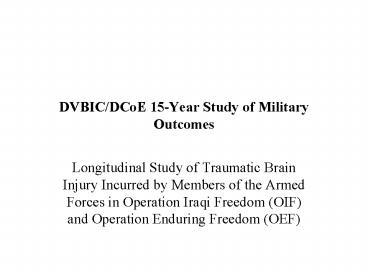DVBICDCoE 15Year Study of Military Outcomes
1 / 13
Title:
DVBICDCoE 15Year Study of Military Outcomes
Description:
DVBIC/DCoE 15-Year Study of Military Outcomes ... 'The Secretary of Defense shall conduct a ... Returnees with mild TBI screened at Fort Bragg and Fort Carson ... –
Number of Views:281
Avg rating:3.0/5.0
Title: DVBICDCoE 15Year Study of Military Outcomes
1
DVBIC/DCoE 15-Year Study of Military Outcomes
- Longitudinal Study of Traumatic Brain Injury
Incurred by Members of the Armed Forces in
Operation Iraqi Freedom (OIF) and Operation
Enduring Freedom (OEF)
2
Congressional Language
- The Secretary of Defense shall conduct a
longitudinal study on the effects of traumatic
brain injury incurred by members of the Armed
Forces serving in Operation Iraqi Freedom or
Operation Enduring Freedom on the members who
incur such an injury and their families. - H.R. 5122 SEC. 721 109th Congress, (a).
3
Specific Congressional Requirements
- Conducted for 15 years
- Elements to be addressed
- Long term physical and mental health effects
- Health care, mental health care, and
rehabilitation needs - Type and availability of long-term care and
rehabilitation - Effect on family members
- Consultation with DVA on Periodic and Final
Reports - H.R. 5122 SEC. 721 109th Congress, (b) through
(e).
4
Need for Longitudinal Assessment
- Long term outcomes after TBI are not well
documented in military or civilian populations.
According to CDC, WHO, and other advisory panels
and commissions, longitudinal studies of TBI are
needed. - Accurate data on outcomes are essential in order
for DoD and DVA to estimate costs, and to
determine requirements for treatment, and future
needs for services and rehabilitation.
5
Time Line for Study
- 2008 Study Design, scientific review,
- 2008 Study submitted to participating IRBs
- 2009-2010 Cohort 1 recruited.
- 2011-2012 Cohort 2 recruited.
- 2013-2014 Cohort 3 recruited.
- 2009-2023 Yearly follow-up interviews.
- Clinical follow-ups at 2, 5, and 10 years after
recruitment. - Congressional Reports at 3, 7, 11, and 15
years. - Yearly review of study methods to take into
account new findings and innovations
6
Collaborators
- Centers for Disease Control and Prevention
Collaborate on study design, follow-up
instrument, collect parallel information on a
matched civilian population - Uniformed Services University
- Collaborate on study design, and reports,
conduct pain sub-study. - Neurotrauma Foundation
- Consult on instruments, and study design,
particularly for moderate to severely injured
patients. - Department of Veterans Affairs
- Provide tracking of patients treated in DVA
facilities, qualitative assessment of injury.
7
Reports and Publication Plan
- Reports to Congress 3, 7, 11, and 15 year marks
summarizing findings to date, and summaries of
all publications and presentations. - Presentations and Publications
- Baseline findings will be presented in an
online/hardcopy report with basic descriptions
and expert summaries for each area of the study. - Analytic papers and reports will be presented and
published for each follow-up period on the risk
factors for TBI, factors affecting outcomes after
TBI, and their association with pre-injury
characteristics. - Additional reports will summarize costs quality
of life and family issues related to military
TBI.
8
Study Design
- Follow-up study of 1200 military personnel who
incurred TBI in Iraq or Afghanistan. Mild,
moderate, and severe TBI will be included. - Overtime assessments
- Yearly telephone interviews (CDC/DVBIC interview)
- Subsample (n400) followed with in-depth
clinical evaluations - Military and DVA databases
- Matched comparison groups
- Civilian Sample CDC Study
- Service members without TBI
9
DVBIC/DCOE 15-year Study of War-related TBI
Outcomes
Post concussive symptoms PTSD Other injuries
Outcomes employment quality of life costs
Pre-injury Factors age education prior TBI/PH
Mediating factors
TBI
Blast
10
Populations Included
- Patients diagnosed with TBI at Landstuhl and
medically evacuated to DVBIC military and DVA
facilities. - Returnees with mild TBI screened at Fort Bragg
and Fort Carson - Returnees diagnosed with TBI at WRAMC
11
Study Costs
- Projected total costs over 15 years are 23.3
million for military studies and 4.1 million for
civilian study. (unadjusted for inflation) - DCoE has requested costs be included in POM for
stability of funding over time. - Costs borne by
- DVBIC for years 1 and 2
- DCoE for years 3 to 15.
12
Important Dimensions Included
- Long term outcomes of TBI at all severity levels.
- Careful assessment of PTSD.
- Influence of associated injuries and conditions,
including depression, amputations, and burns on
recovery. - Determine genetic susceptibility for poor
recovery and community re-integration - Association of clinical biomarkers and
neuroimaging findings with recovery. - Assessment of treatment and rehabilitation costs,
and caregiver burden. - Determine the long term impact of TBI on
independence, productivity, and quality of life.
13
What We Will Know from the Study
- Long term physical and mental health effects
- Health care, mental health care, and
rehabilitation needs - Impact on family members
- Factors influencing recovery































